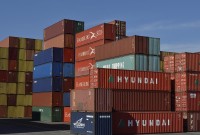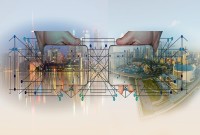- Home
- Business Processes
- Industry Knowledge
- Aerospace Industry
- Automotive Industry
- Banking Domain
- BFSI Industry
- Consumer/ FMCG Industry
- Chemicals Industry
- Engineering & Construction
- Energy Industry
- Education Domain
- Finance Domain
- Hospitality Domain
- Healthcare Industry
- Insurance Domain
- Retail Industry
- Travel and Tourism Domain
- Telecom Industry
- Leadership Skills
- eLearning
- Home
- Business Processes
- Warehouse Management
- Miscellaneous Warehouse Processes
Miscellaneous Warehouse Processes
At the end of each inventory control, the Contractor provides the Ordering Person with an inventory report which contains a list of all stock adjustments. The Ordering Person uses the report to create, by use of his/her own means, necessary value and accounting adjustments related to the stock. Let us look at some to the mislaneous warehouse processes not covered earlier.
Let us look at some to the mislaneous warehouse processes not covered earlier.
- At the end of each inventory control, the Contractor provides the Ordering Person with an inventory report which contains a list of all stock adjustments. The Ordering Person uses the report to create, by use of his/her own means, necessary value and accounting adjustments related to the stock.
- Management of Source Documents (Sales orders, returns, transfer orders, production orders, and kanban)
- Location stocking limits
- Location volume Metrics
- Inventory Status
- Batch and serial item support
- Item receiving capabilities
- Multiple picking strategies
- Barcode scanners
- Pallet/container types
- Advanced counting capabilities
- Label printing and label routing
- Business intelligence
- Movement of inventory
- Quality Control
- Outbound wave processing
- Manual packing
- Containerization support
- Cluster picking
- Simple cross docking
- Production order
- Kanban
- Pick operation
- Put operation
- Transferring inventory from one location to another
- Work Pools: Work pools are used to organize work into groups. For example, you can create a work pool to classify work that occurs in a particular warehouse location.
- Staging Area
- Location Directives: Location directives are used to direct the work transactions to the appropriate locations in the warehouse. They define where to pick and put.
- FEFO Batch Reservation Strategy
- Outbound Sales Picking
- Advanced shipment notice (ASN)
- Item Velocity: The velocity code of a product is a measure of its movement in the supply chain. Products are classified as having a velocity code A, B, or C. Velocity code A indicates fast moving items and C indicates slow moving items. The speed at which an item moves varies by regions, seasons, and other parameters. For example, during winter, snow jackets can sell more on the east coast of the US than on the west coast.
- Product Items: A product item is a physical unit that can be ordered, shipped, and returned. A product item is uniquely defined by its item ID and unit of measure. You can configure items, units of measure, master catalogs, categories, classifications, and additional item attributes.
- SKU: In the field of inventory management, a stock keeping unit (SKU) is a distinct type of item for sale and has attributes associated with it that distinguish it from other item types. For a product, these attributes can include manufacturer, description, material, size, color, packaging, and warranty terms. SKU can also refer to a unique identifier or code, sometimes represented via a barcode for scanning and tracking, that refers to the particular stock keeping unit. These identifiers are not regulated or standardized.
- Preparation: Preparation is one of the warehouse operations performed to prepare a product for sale. Businesses often sell their products in sets. Such a set may consist of goods from different manufacturers, which arrived at the warehouse as different deliveries. Preparation is creating a set (a new “product”) from a number of different, single products. It allows businesses to put a set in the cart, rather than several individual products. The warehouse is able to complete such an order more quickly as it has sets ready to be released.
- Goods Insurance: Warehouse Insurance offers comprehensive coverage for losses arising due to damage to warehouse building, the goods stored in it or the machinery stored in it. It also offers coverage for the loss of profits arising out of the damage. The warehouse and all the goods stored should be insured to their full value at all times as a best practice. Someone should be assigned to manage for all formalities related to the insurance of the warehouse and goods.
- Warehouse Entry Process: All visits should be authorized and should be conducted only in the presence of the Warehouse Manager/Authorized person. Visits should not interfere with the regular operations of the warehouse. All visitors should comply with the safety procedures applicable at the warehouse, with all health and safety regulations related to visiting the warehouse, and with all instructions given by the Warehouse Manager etc.
- Turnaround time: Efficiency of a warehouse depends on how quickly it deals with delivery vehicles. Turnaround time for warehouse is the time taken between a vehicle arriving and departing. This is important because transport operators get paid for having their vehicles moving, and want to minimize the idle time during loading or unloading.
Related Links
You May Also Like
-
Transport operations are often divided into full load and part load and due to economies of scale, the unit costs are higher for part loads. Our customer needs several part loads delivering, so it can reduce costs by consolidating these into full loads. Then it gets all the part loads delivered to a warehouse near the suppliers, consolidates them into full loads, and pays the lower costs of full-load transport to its operations.
-
Warehouses may seem like a simple, straightforward concept, but they actually include a variety of different types of warehouses that all have their own niche. The type of warehousing that’s right for you depends on your specific industry, location, and needs. From private warehousing, distribution centers, and climate-controlled warehouses, there’s an option to suit every business.
-
Business Case of Multiple Warehouses
Adding extra warehouses to business provides many benefits such as reducing shipping costs, increasing storage capacity, and having warehouses for specific purposes to simplify overall warehouse management. Multiple warehouses allow you to organize your inventory in a way that helps your business be more effective.
-
Types of Inventory Count Processes
While dealing with lots of inventory in a warehouse, lots of things can go wrong. Shipments may not have the right number of units in them, or they could get damaged somewhere along the supply chain. Discrepancies in the stock may arise as part of every inventory control, and need to be corrected immediately after the inventory control procedure has been finished.
-
One of the warehousing best practices that retailers like Walmart, Amazon, and Target have adopted is known as cross-docking. During this process the inbound products are unloaded at a distribution center and then sorted by destination, and eventually reloaded onto outbound trucks. In real parlance, the goods are not at all warehoused but just moved across the dock (hence the name).
-
In the normal course of business, customers are likely to return orders from time to time due to various reasons and business should design processes the manage and accept such returns. A well designed returns management process can reduce costs and issues associated with returns or exchanges.
-
Overview of Warehouse Processes
The basic function of a warehouse is to store goods. This means that they receive deliveries from suppliers, do any necessary checking and sorting, store the materials until it is dispatched to customers. Traditionally warehouses were seen as places for the long-term storage of goods. Now organizations want to optimize their customer experience and try to move materials quickly through the supply chain, so the role of warehousing has changed.
-
What is the difference between Warehouse Management & Inventory Management?
The terms “inventory management” and “warehouse management” are sometimes mistakenly used interchangeably as they both deal with operations and products of industries. Despite their few similarities, there are many notable differences between warehouse and inventory management systems.
-
When a customer wants a product that has been stored in the warehouse, the same need to be picked off the shelf (or off the floor) and get it ready for shipping. Depending on how big is the warehouse, picking can take a while. (Many distribution centers cover more than 1 million square feet.). Hence, warehouse order picking methods are an important aspect within any warehouse.
-
When products arrive at a facility, there need to be a defined process to let them in. The process for accepting inventory when it arrives is called "Receiving". Any warehousing operation must be able to receive inventory or freight from trucks at loading docks and then stow them away in a storage location. Receiving often involves scheduling appointments for deliveries to occur, along with unloading the goods and performing a quality inspection.
Explore Our Free Training Articles or
Sign Up to Start With Our eLearning Courses

About Us
Learning
© 2023 TechnoFunc, All Rights Reserved











